Oxford, New Zealand
Oxford (Māori: Ōkiwhata)[4] is a small town serving the farming community of North Canterbury, New Zealand. It is part of the Waimakariri District and is a linear town, approximately 2 kilometres (1.2 mi) long. Originally, it was served by the Oxford Branch railway, and had two stations, East Oxford and West Oxford. The line closed in 1959 and was dismantled. Some railway signs and the remnants of railway platforms can still be seen along Oxford Road on the way to Rangiora.
Oxford | |
|---|---|
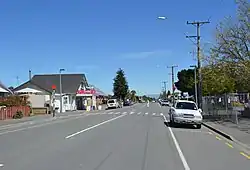 The main street (Inland Scenic Route) of Oxford | |
| Coordinates: 43°18′46″S 172°11′26″E | |
| Country | New Zealand |
| Region | Canterbury |
| Territorial authority | Waimakariri District |
| Ward | Oxford-Ohoka Ward |
| Community | Oxford-Ohoka Community |
| Electorates |
|
| Government | |
| • Territorial Authority | Waimakariri District Council |
| • Regional council | Environment Canterbury |
| • Mayor of Waimakariri | Dan Gordon |
| • Waimakariri MP | Matthew Doocey |
| • Te Tai Tonga MP | Tākuta Ferris |
| Area | |
| • Total | 11.83 km2 (4.57 sq mi) |
| Population (June 2023)[3] | |
| • Total | 2,380 |
| • Density | 200/km2 (520/sq mi) |
| Time zone | UTC+12 (NZST) |
| • Summer (DST) | UTC+13 (NZDT) |
| Postcode(s) | 7430 |
| Area code | 03 |
| Website | www |
It was originally a logging town: trees were felled from forests in the area, and hauled by beast to Christchurch. A mural depicting life from that era is painted on the side wall of the butchers shop.
Oxford has won awards for the most beautiful village and the most beautiful toilet.[5]
Geography
Oxford is located at the inland edge of the Canterbury Plains, approximately 50 km northwest of Christchurch. The township is about 30 km from Rangiora to the East, and the townships of Sheffield and Darfield to the west.
The climate of Oxford is warm and temperate. Snowfalls are rare, but surrounding hills get snowfall on an annual basis.
Naming
It is unclear whether the town is named after Oxford in England or after its university, but it is more probable that it was named after Samuel Wilberforce, who was the Bishop of Oxford from 1845 to 1870. It was named by the chief surveyor of the Canterbury Association, Joseph Thomas, in 1849.[6][7]
The town of Tīrau in the North Island was originally also named Oxford, in a name pairing with Cambridge 30 km to the west. Owing to confusion between the two towns, the North Island town was later renamed Oxford North before adopting its current name in 1895.
Education
The town has one school, Oxford Area School.[8] It is a state composite (Year 1–13) school with a role of 477 students (as of April 2023).[9]
Demographics
Oxford covers 11.83 km2 (4.57 sq mi).[2] It had an estimated population of 2,380 as of June 2023,[3] with a population density of 201 people per km2.
| Year | Pop. | ±% p.a. |
|---|---|---|
| 2006 | 1,728 | — |
| 2013 | 1,929 | +1.58% |
| 2018 | 2,214 | +2.79% |
| Source: [10] | ||

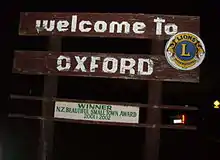
Oxford had a population of 2,214 at the 2018 New Zealand census, an increase of 285 people (14.8%) since the 2013 census, and an increase of 486 people (28.1%) since the 2006 census. There were 858 households, comprising 1,068 males and 1,146 females, giving a sex ratio of 0.93 males per female. The median age was 45.1 years (compared with 37.4 years nationally), with 456 people (20.6%) aged under 15 years, 309 (14.0%) aged 15 to 29, 909 (41.1%) aged 30 to 64, and 540 (24.4%) aged 65 or older.
Ethnicities were 95.3% European/Pākehā, 6.6% Māori, 0.9% Pasifika, 1.5% Asian, and 2.2% other ethnicities. People may identify with more than one ethnicity.
The percentage of people born overseas was 19.8, compared with 27.1% nationally.
Although some people chose not to answer the census's question about religious affiliation, 52.6% had no religion, 36.2% were Christian, 0.1% were Hindu, 0.1% were Buddhist and 2.0% had other religions.
Of those at least 15 years old, 234 (13.3%) people had a bachelor's or higher degree, and 435 (24.7%) people had no formal qualifications. The median income was $26,900, compared with $31,800 nationally. 228 people (13.0%) earned over $70,000 compared to 17.2% nationally. The employment status of those at least 15 was that 729 (41.5%) people were employed full-time, 288 (16.4%) were part-time, and 54 (3.1%) were unemployed.[10]
Community
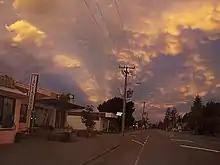
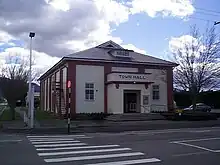
The community saved hard during 2005 and 2006 to raise funds for projects such as the Oxford Community Pool, a community-based swimming pool in Burnett Street, and a first-response ambulance. The town prides itself on its ability to self-fund community projects through organizations such as the Lions.
Oxford has several Churches and organisations:
- Waimak Bible Chapel (Brethren)
- Oxford Union Church (Presbyterian)
- Oxford Baptist Church
- Sacred Heart Catholic Church
- Seventh Day Adventist Church
- Anglican Church
- Tawera Masonic Lodge
- Oxford Working Men’s Club
- West Oxford Hotel (Public House - The West)
Notable people
- Joseph Pawelka (1887–?), New Zealand criminal and prison escaper[11]
- Bernard Sladden (1879–1961), farmer, wildlife ranger, historian and naturalist[12]
- Jo Seagar, chef [13]
Transport
Oxford was linked to Christchurch in 1878 by the narrow-gauge Oxford Branch from Oxford West to Rangiora to meet the broad gauge from Christchurch. With the gauge conversion of 1878, it became easier to transfer passengers and freight from the branch line to Christchurch, though passengers still had to change at Rangiora from the Waipara train to the branch train. The branch stretched from Rangiora through Bennetts Junction (where the Eyreton Branch joined), Oxford and Sheffield. This necessitated a high road-rail bridge across the Waimakariri Gorge.
From Oxford to Sheffield closed in 1931 along with the Eyreton Branch, leaving the Oxford branch as a rural branch line. It lost its passenger service in the 1940s. Due to declining revenue, the branch closed on 31 May 1959 and the track was sold to Scotts Engineering of Christchurch, which used the rails from several branch lines to build farm sheds.
The line was latterly worked by the A and AB class 4-6-2 and C class 2-6-2 tender locomotives. No diesel locomotives or railcars are known to have used the branch, although thought was given in the 1940s to running a small railcar.
Oxford Benevolent and Improvement League
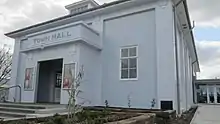
The OB&I was formed during World War I to provide charitable support to war widows. To raise money, it showed films in the old Oxford Town Hall. It provides charitable support to the citizens of Oxford. Movies are screened in the Town Hall approximately every other Saturday during the winter. The heyday of the OB&I movies was the middle of the 20th century, when three or four films would be shown every week and queues often extended around the building. This was before private car ownership became popular, as the nearest cinema was in Christchurch, some 50 km distant.
The Oxford Town hall, where movies were shown, was closed, along with several other Council operated buildings, in late 2011, as the building was determined to be earthquake prone.[14] The Oxford Town hall was reopened on 19 February 2015.[15]
Renovation of Main Street
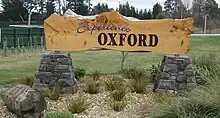
During 2009, Main Street underwent a major renovation with the road resurfaced, pedestrian refuges in strategic locations and new footpaths with garden beds. The old welcome signs were replaced with new "Experience Oxford" signs at east and west entries. This project was a joint undertaking by the Waimakariri District Council and the Oxford Promotions and Action Committee (OPAC), but they ran out of money and did not finish both sides of the street.
Books about Oxford
There are a number of books about Oxford.
Littledene: a New Zealand rural community[16] published in 1938 is perhaps the most comprehensive; the book is a "sociological study of a typical New Zealand small town", with the fictional name of Littledene, but the research and details of the book all relate to Oxford.
References
- "Electorate Boundaries". Archived from the original on 8 February 2013. Retrieved 7 June 2015.
- "ArcGIS Web Application". statsnz.maps.arcgis.com. Retrieved 29 August 2021.
- "Subnational population estimates (RC, SA2), by age and sex, at 30 June 1996-2023 (2023 boundaries)". Statistics New Zealand. Retrieved 25 October 2023. (regional councils); "Subnational population estimates (TA, SA2), by age and sex, at 30 June 1996-2023 (2023 boundaries)". Statistics New Zealand. Retrieved 25 October 2023. (territorial authorities); "Subnational population estimates (urban rural), by age and sex, at 30 June 1996-2023 (2023 boundaries)". Statistics New Zealand. Retrieved 25 October 2023. (urban areas)
- "Ōkiwhata - te Aka Māori Dictionary".
- Waimakariri District Council (2000). District public toilet strategy (PDF) (Report). Retrieved 30 July 2016.
- Reed, A. W. (2010). Peter Dowling (ed.). Place Names of New Zealand. Rosedale, North Shore: Raupo. p. 297. ISBN 9780143204107.
- Hight, James; C. R. Straubel (1957). A History of Canterbury: Volume I : to 1854. Christchurch: Whitcombe and Tombs Ltd. p. 120.
- "Oxford Area School Website". Retrieved 30 April 2014.
- "New Zealand Schools Directory". New Zealand Ministry of Education. Retrieved 12 December 2022.
- "Statistical area 1 dataset for 2018 Census". Statistics New Zealand. March 2020. Oxford (313200). 2018 Census place summary: Oxford
- Wills, John D. "Joseph John Thomas Pawelka". Dictionary of New Zealand Biography. Ministry for Culture and Heritage. Retrieved 23 April 2017.
- Rorke, Jinty. "Bernard Sladden". Dictionary of New Zealand Biography. Ministry for Culture and Heritage. Retrieved 23 April 2017.
- "Jo Seagar 'gutted' by cafe closure". NZ Herald. Retrieved 17 October 2022.
- "Quake damage closes six buildings | Stuff.co.nz". 15 December 2011.
- "Oxford Town Hall | Waimakariri District Council".
- "Littledene | NZHistory, New Zealand history online".
External links
![]() Media related to Oxford, New Zealand at Wikimedia Commons
Media related to Oxford, New Zealand at Wikimedia Commons
- Oxford website
- Somerset, H. C. D. (1938). Littledene: A New Zealand rural community. Wellington: New Zealand Council for Educational Research.